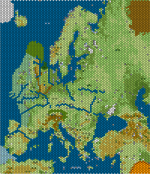Shades of Eternity
Legend
This is a world I've been kicking around.
Several threads here started me stewing on this a long time ago.
Namely.
Peasant Revolts in 5e

 www.enworld.org
www.enworld.org
and
Giant Snails in medieval manuscipts

 www.enworld.org
www.enworld.org
as well as

 www.enworld.org
www.enworld.org
and finally

 www.enworld.org
www.enworld.org
I have made a medieval world that mixes in traditional Christianity, the Canterbury tales, the Norman Invasion, Medieval Myths and legends, Doggerland and the Smurfs .
.
#DnD #TTRPG #Worldbuilding #Fantasy #MedievalFantasy #ChristianFantasy #Pilgrimage #DivineMagic #MythicalCreatures #Homebrew #RoleplayingGame #TabletopGaming #FantasyMap #Storytelling #EpicAdventure
Here is my overview
_-_geograph.org.uk_-_3539738.jpg)
 breadthofpopsanity.blogspot.com
breadthofpopsanity.blogspot.com
I'll post the next parts over the next month or so.
Several threads here started me stewing on this a long time ago.
Namely.
Peasant Revolts in 5e

D&D 5E - Peasant Revolts in 5e
We've all seen the old joke where a town has to run for its life because a high-level adventurer needs a couple of experience points to get to the next level. Is it even possible to do a peasant's revolt in Dungeons and Dragons? Essentially how to gamify the following historical event...
 www.enworld.org
www.enworld.org
and
Giant Snails in medieval manuscipts

D&D 5E - Giant Snails in Medieval Manuscripts.
https://www.smithsonianmag.com/smart-news/why-were-medieval-knights-always-fighting-snails-1728888/ Okay, I'm asking, In medieval manuscripts, we have a surprising number of knights fighting giant snails. How did this great pestilence come to being in your dnd game? Were they a symbol of...
 www.enworld.org
www.enworld.org
as well as

D&D 5E (2014) - New Monster - The Vorpal Rabbit
Inspired by a certain manuscript: Vorpal Rabbit You see a small rabbit humanoid with a big weapon moving at a rapid speed. Innocence Enraged. Vorpal Rabbits often materialize as a sign of punishment of ill-gotten deeds. They are a sign of the weak finally getting up and fighting the good...
 www.enworld.org
www.enworld.org
and finally

D&D General - Which medieval monsters are different then their dnd equivalent?
Besides listing your favorite creatures from this era, how has dungeons and dragons changed monsters from this time and history and was it better or for worse?
 www.enworld.org
www.enworld.org
I have made a medieval world that mixes in traditional Christianity, the Canterbury tales, the Norman Invasion, Medieval Myths and legends, Doggerland and the Smurfs
#DnD #TTRPG #Worldbuilding #Fantasy #MedievalFantasy #ChristianFantasy #Pilgrimage #DivineMagic #MythicalCreatures #Homebrew #RoleplayingGame #TabletopGaming #FantasyMap #Storytelling #EpicAdventure
Here is my overview
_-_geograph.org.uk_-_3539738.jpg)
The Elderberry Tales - Part 1 - Overview and Background
The King is Dead, and the Bastard Reigns Supreme It was not supposed to be this way. Our King fought well, but he was already tired before ...
I'll post the next parts over the next month or so.
Last edited:






